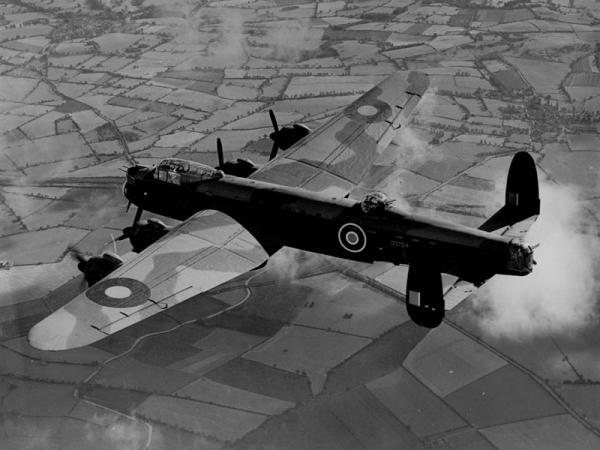
By Arthur Hoyle
"Late on the night of 26 April, 1944, 25 Lancasters from 460 squadron headed for Essen in the middle of the Ruhr. Almost over the target, Vic. Our bomb aimer took over and began the familiar, "Left, left, steady, right, steady, bomb doors open, steady, right, steady, bombs gone, steady for photo". When the 14,000 lbs of bombs fell away the aircraft leapt upwards as it was relieved of the weight.
A moment later, with the bomb doors still open and the aircraft steady on course, the plane rocked as a shower of bombs hit us from a Lancaster just over our heads. Fortunately, the 4,000 lb bomb missed us or we would have been blown to Kingdom Come. We were hit by a shower of incendiaries which immediately knocked out one engine and badly damaged another so that it was useless and the propeller could not be feathered, greatly increasing the drag on one side of the plane. A third motor was hit but kept going on reduced power. Another incendiary damaged the starboard fuel tank but did not set it alight. Yet anther smashed the hydraulic system which operated the bomb doors, undercarriage and flaps. By a miracle no one was hit.
The Lancaster had started to dive away to port and the pilot and engineer struggled and brought the plane under control. With limited control and lack of speed giving us a much reduced airspeed, the skipper opted for a direct flight to base, even though we would be on our own across Germany.
Losing altitude as we approached the Dutch coast we decided on the long sea crossing hoping to maintain enough height to make England. As we crossed the sea in the early hours of the morning the aircraft gradually lost height. With the bomb doors wide open, the bomb inspection covers had blown off and an icy gale whistled through the cabin. On two motors and the third propeller uselessly windmilling adding to the drag, we could go no faster than 140mph.
At 0345 we crossed the darkened coast of Lincolnshire at 1500 feet and turned for the short leg to Binbrook. In sight of the base beacon the third motor stopped. Bob, at once, feathered the engine and we began to lose what little altitude we had. We were now down to 600 feet above the Wolds.
Bob called up flying control and asked for an emergency landing. To our incredulity and disgust, we were refused and told to go away to an emergency airfield in East Anglia.
Because we were arriving at the same time as the rest of 460 squadron aircraft flying control didn't want the runway blocked by a crashed aircraft. Bob Wade, with an understandably temper outburst at this callous unconcern by flying control for a Lancaster in such dire straits, told flying control with a few Australian adjectives included ignored the instructions and continued the approach telling Harry to operate the emergency lever to lower the undercarriage.

Just imagine coming in on a wing and a prayer. One motor, one wheel, and one ambition to get down in one try.
The only difference in this picture is that 460 squadron Lancs had Rolls Royce in line motors.
Only the right wheel came down and when an attempt was made to retract it, it remained down. With one engine working, one propeller windmilling, the bomb doors open, no flaps and one wheel up and one wheel down, and too low to bale out our only option was to ride the Lancaster to the ground.
Not wanting to block the runway, after telling control he was coming in whether they liked it or not, Bob lined up some 300 yards to the right. Even though it was very dark off to the side of the runway, he began the short final approach with no flaps to maintain lift at our low speed and holding the right wing low to counter balance the dead engines.
The Lancaster "B2" touched down on one wheel and ran along the grass at about 100 mph while Bob fought in the dark to keep the left wing up as long as possible. Gradually the wing sank lower and as the speed dropped shut off the last throttle. Suddenly the left wing tip touched the ground and immediately the aircraft ground–looped violently, spinning across the grass and finally coming to rest in the middle of the runway, right in the path of another Lancaster which was on the point of touching down.
As our aircraft came to rest their was a wild scramble to get clear in case the damaged fuel tank caught fire. First man out got stuck in the escape hatch but was quickly shoved out by those following.
Scrambling down the fuselage we ran for our lives. In the glow of the searchlight, the fire truck and ambulance raced across the grass, but we did not hear them because of the shattering roar of the engines of the Lancaster which had just touched down. Faced with a wrecked Lancaster in the middle of the runway, the pilot gunned his motors to emergency power and slowly struggled over our heads to safety. As the roar of the climbing aircraft died away, even though I was about 40 yards away, I knew Bob was still alive as I could hear him cursing and swearing as he turned off the switches.